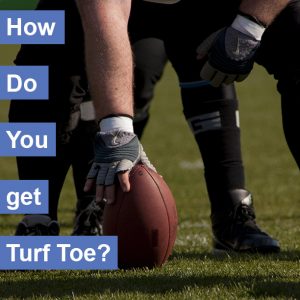If you follow professional sports, then you’ve probably heard the term “turf toe” at least once while listening to an injury report or perhaps seen it traveling across the bottom ticker on ESPN.
Although the name itself can evoke visions of a fungal infection, turf toe actually occurs when the joint just below the big toe — also known as the first metarsophalangeal joint — suffers a sprain. These injuries can also include damage to the ligaments as well as the joint capsule and often cause immense pain whenever the afflicted athlete attempts to walk, jog, jump, or run.
So why is it called “turf toe”?
Well, the name “turf toe” comes from the fact that this injury appears most often in athletes — both professional and amateur — who play on artificial turf. When playing sports on artificial turf, the foot can stick to the hard surface, resulting in jamming of the big toe joint. Although this injury is most commonly reported in football and soccer players, it is not uncommon to see the injury occur in other sports such as basketball, wrestling and gymnastics.
And while most turf toe injuries do occur on artificial turf, in reality this hyperextension injury can occur anytime the toe hits a hard, unyielding surface that forces the toe beyond its normal range of motion.
The effects of turf toe can range from a mild injury with only minor ligament damage to a chronic injury involving inflammation of the joint capsule and progressive cartilage formation and calcification of the head of the first metatarsal.
In order to determine the severity of the injury, a doctor will need to examine the foot, noting the pattern and location of any swelling and comparing the injured foot to the uninjured one. It is also likely that advanced images such as an X-ray, CT scan or MRI will be conducted in order to rule out any further damage.
If you believe you are suffering from turf toe, it is important to stick to the R.I.C.E. treatment plan – a combination of rest, ice, compression, and elevation — until a doctor can further examine the injury. Once examined, the doctor may tape or strap it to the toe next to it to relieve the stress on it or prescribe a cast or special walking boot. In severe cases, an orthopaedic surgeon may be required for a surgical intervention.
The recovery time for this injury ranges from three to four weeks depending on how bad the sprain is.
In order to prevent turf toe, it is important to always wear shoes with good support to help keep the toe joint from excessive bending. If you train frequently on artificial turf or any other hard surface, a doctor can prescribe a specially designed insert for your shoe to offer even greater protection.
—
Follow Delray Beach Podiatry on Twitter @Delray_Podiatry
The content on this website is for informational purposes only. Do not rely or act upon information from www.DelrayBeachPodiatry.com without seeking professional medical advice. If you live in South Florida and would like a consultation with Dr. Ian Goldbaum, a podiatric physician and surgeon with over 30 years of experience, please see our contact information below:
BOCA/DELRAY
16244 S. Military Trail #290, Delray Beach, FL 33445
561-499-0033
BOYNTON BEACH
8198 Jog Road #100, Boynton Beach, FL 33472
561-499-0033


No responses yet